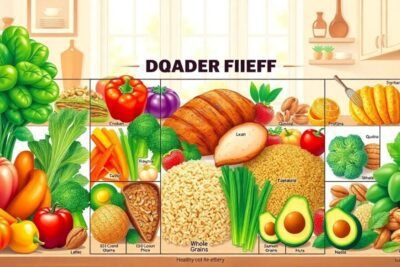
What kind of diet is best for a diabetic
Managing diabetes effectively requires a well-structured diet that keeps blood sugar levels stable. Understanding what kind of diet is best for a diabetic can empower individuals to make informed choices and lead healthier lives. This article explores the essentials of a diabetes-friendly diet, including foods to embrace and those to avoid.
By adapting dietary habits, individuals can significantly enhance their well-being and prevent complications associated with diabetes. Let’s delve into the details of a nutritious eating plan tailored for diabetic needs.
- What kind of diet is best for a diabetic?
- What are the top 10 foods for a healthy diabetes diet?
- What foods should I eat if I have diabetes?
- What foods should diabetics avoid?
- How can I plan what to eat or drink when I have diabetes?
- What are the healthiest foods for a person with type 2 diabetes?
- How can physical activity help manage my diabetes?
- Frequently asked questions about managing diabetes with diet
What kind of diet is best for a diabetic?
A diabetes diet focuses on maintaining balanced blood sugar levels while providing essential nutrients. This involves consuming a variety of nutrient-rich foods that support overall health. Some important components include:
- Whole grains: Opt for brown rice, quinoa, and whole grain bread to provide fiber and slow-release carbohydrates.
- Fruits and vegetables: Incorporate a wide array of colorful options, particularly non-starchy vegetables, to ensure a rich source of vitamins and minerals.
- Lean proteins: Include sources like chicken, turkey, fish, and plant-based proteins to support muscle health.
- Healthy fats: Incorporate nuts, seeds, and olive oil to promote heart health while managing overall calorie intake.
When considering what kind of diet is best for a diabetic, it’s crucial to limit high-sugar and high-fat foods. These can cause spikes in blood glucose levels. Regular meal timing and portion control are also key strategies for effective diabetes management.
What are the top 10 foods for a healthy diabetes diet?
Building a diabetes-friendly diet involves including a variety of foods. Here are the top 10 foods that can significantly benefit those managing diabetes:
- Leafy greens: Spinach and kale are low in calories and high in nutrients.
- Berries: Blueberries, strawberries, and raspberries provide antioxidants and fiber.
- Fatty fish: Salmon and mackerel are rich in omega-3 fatty acids, supporting heart health.
- Nuts: Almonds and walnuts help regulate blood sugar and provide healthy fats.
- Legumes: Beans and lentils are excellent sources of fiber and protein.
- Greek yogurt: Offers probiotics and protein while being lower in sugar.
- Sweet potatoes: A nutritious carbohydrate choice that is high in fiber.
- Quinoa: A versatile whole grain that is high in protein and fiber.
- Chia seeds: Packed with omega-3 fatty acids, fiber, and protein.
- Olive oil: A healthy fat option that can improve heart health.
Incorporating these foods can enhance the healthy eating choices for diabetes while ensuring balanced nutrition. A varied diet not only helps manage blood sugar levels but also improves overall health.
What foods should I eat if I have diabetes?
Individuals with diabetes should focus on foods that promote stable blood sugar levels and provide essential nutrients. Recommended food categories include:
- High-fiber foods: Such as whole grains, legumes, and vegetables, which aid digestion and help maintain blood sugar levels.
- Lean proteins: Like chicken, turkey, fish, and plant-based proteins to support muscle health and keep you feeling full.
- Healthy fats: Incorporating sources like avocados, olive oil, and nuts can support heart health.
Additionally, focusing on portion control and balancing meals is vital. Combining carbohydrates with protein can help slow down the absorption of sugars, thus assisting in managing blood glucose levels effectively.
What foods should diabetics avoid?
To effectively manage diabetes, it is crucial to steer clear of certain foods that can lead to spikes in blood sugar levels. Here are some foods to avoid:
- Sugary beverages: Sodas and sweetened drinks can lead to rapid increases in blood sugar.
- White bread and pastries: These foods are often made with refined flour, which can raise blood glucose levels.
- Full-fat dairy: High in saturated fats, which can raise cholesterol levels and increase the risk of heart disease.
- Processed snacks: Chips and candy often contain added sugars and unhealthy fats.
Avoiding these foods can play a significant role in maintaining healthy blood sugar levels. Making informed food choices is essential for long-term diabetes management.
How can I plan what to eat or drink when I have diabetes?
Planning meals is a critical aspect of managing diabetes effectively. Here are some strategies for meal planning:
Utilizing the Diabetes Plate Method, where half of your plate is filled with non-starchy vegetables, a quarter with lean proteins, and a quarter with whole grains or healthy carbohydrates, simplifies meal planning. This visual guide can help individuals maintain balance and control portions effectively.
Additionally, keeping a food diary can help track what you eat, making it easier to identify how different foods affect your blood sugar levels. Regular consultations with a registered dietitian can also lead to a tailored diet plan that meets personal health goals.
What are the healthiest foods for a person with type 2 diabetes?
For individuals with type 2 diabetes, focusing on nutrient-dense foods is key. Some of the healthiest foods include:
- Non-starchy vegetables: Aim for a variety of colors to maximize nutrient intake.
- Whole grains: Brown rice, barley, and whole grain bread provide fiber and help regulate blood sugar.
- Healthy proteins: Fish, poultry, beans, and nuts support muscle health and provide sustained energy.
Incorporating these foods can enhance overall health while ensuring that blood sugar levels remain stable. It is also important to stay hydrated and choose low-calorie beverages, such as water or herbal tea, to complement a healthy diet.
How can physical activity help manage my diabetes?
Physical activity plays a vital role in diabetes management. Regular exercise can help improve insulin sensitivity, allowing the body to use glucose more effectively. Engaging in activities like walking, swimming, or cycling can lower blood sugar levels and improve heart health.
Combining aerobic exercise with strength training can yield even greater benefits. Aim for at least 150 minutes of moderate-intensity aerobic activity each week, along with muscle-strengthening exercises on two days.
Incorporating physical activity into your daily routine not only helps manage diabetes but also enhances mood, energy levels, and overall well-being. Finding activities that you enjoy can make staying active more sustainable in the long run.
Frequently asked questions about managing diabetes with diet
What is the best diet for a diabetic person?
The best diet for a diabetic person emphasizes whole foods and minimizes processed items. This includes a variety of fruits, vegetables, whole grains, lean proteins, and healthy fats. A balanced approach helps maintain stable blood sugar levels and supports overall health.
What foods can a diabetic eat freely?
While moderation is essential, many foods are generally safe for diabetics to enjoy without significant concern. These include non-starchy vegetables like spinach, broccoli, and peppers, as well as whole grains like quinoa and brown rice. Additionally, fruits such as berries and apples can be consumed in moderation, offering fiber and nutrients without excessive sugars.
What is the first thing a diabetic should eat?
A diabetic's first meal of the day should ideally include a balance of protein and healthy carbohydrates. Consider options like a vegetable omelet with a side of whole grain toast or Greek yogurt topped with berries. These choices can help regulate blood sugar levels and provide lasting energy throughout the morning.
What foods should diabetics avoid?
Diabetics should avoid foods high in refined sugars and saturated fats. This includes sugary drinks, white bread, pastries, and high-fat meats. Instead, focus on nutrient-dense foods that provide fiber and protein, which can help maintain stable blood sugar levels.










